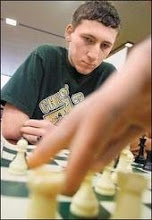Madison - Eichhorn
1. d4 d5 2. c4 e5!?
Ah, the Albin Countergambit. Nary a normal position ahead.
3. dxe5 d4 4. a3 Be6 5. Nf3 Nc6 6. e3
So far so good. White usually can't hold on to the extra pawn, but instead tries to generate play while black takes the time to regain the pawn on e5. e3 threatens to take on d4, which would have white up two pawns and e5 would be tough to take back (which I assume is why e3 is the book move).
6. ...dxe3 7. Qxd8+ Rxd8 8. Bxe3 Nge7 9. Nc3 Ng6 10. Nb5 Rd7
I had been out of book since 4. ...Be6, but Master level games have actually made it to this position before. All of them I could find ended up in draws though.
11. Rd1!N

Only later to find out that the book move was an immediate Nbd4. Haven't found any previous games with this, but I assume it has been played. I figure this is slightly stronger since it challenges the d-file and also really strains the rook on d7, but what do I know?
11. ...a6 12. Nbd4 Ncxe5 13. Nxe5 Nxe5 14. Bf4
Now I am unsure of this move. It is hard to say whether the black knight is worse on e5 or g6. I just wanted to add pressure to c7 and also concluded that the knight would be less active on g6.
14. ...Ng6 15. Nxe6 fxe6
Another point of Bf4 was to lay the easily avoided trap 15. ...Nxf4?? 16. Nxf4! winning a piece.
16. Be3 Be7
This is where it gets a little tricky. During the game I had seen the idea Bf8-e7-f6, and had trouble figuring out how to deal with it. I spent a few minutes mulling it over and then played...
17. Be2 Bf6 18. b3 Bc3+

There is a pretty critical decision here: play Bd2, several exchanges and can I win this endgame? Doubtful despite having the better of it and a pretty safe draw. Or I can play Kf1 and walk into the uncharted desert.
19. Kf1 Rf8
During the game this felt like a mistake to me, but I can't really find anything particularly wrong about it.
20. Rxd7 Kxd7 21. Bd3 e5?!
The idea is to anchor the bishop on d4 and/or possibly play for e4 at some point to disrupt the white pieces. Personally, I prefer ...Ne7 and trying to liquidate the queenside. White can't take on h7 because of ...g6 and ...Rh8.
22. Bxg6!
You might be saying, "But Jeremy, the two bishops is an advantage, especially with an open center and in an endgame!" To which I respond: I like my chances to win better and my chances to lose on a downward spiral when my opponent has shattered pawns and all else is equal. All I have to do is play a flawless endgame, and how hard could that be?
22. ...hxg6 23. Ke2 Ke6 24. Rd1
This rook is a beast on d1.
24. ...b6 25. f3 a5 26. c5?
It looks strong, but simply capturing and ...Rb8 suddenly puts the squeeze on white.
26. ...b5?

27. c6!
This is one of those subtle things that you get to play once in a while. Namely, if my rook is a beast on d1, it must be a demon on d7.
Rh8 28. h3 a4 29. bxa4 bxa4 30. Rd7 Ba5 31. Bd2 Bxd2?
This is the decisive error. From here I felt that the rook ending was completely won for me. I had been calculating 31. ...Bb6 the whole time to close counterplay on the b-file, to which I intended to respond 32. Bb4 with the idea of moving my king up and creating more threats. I can take the pawns at my leisure I think.
32. Kxd2 Rb8 33. Rxc7 Kd6 34. Rb7!
Forces the black rook off of an active file. 34. ...Rxb7?? is a lost king and pawn ending, so...
34. ...Rc8 35. Rxg7 Kxc6 36. Rxg6+ Kb5

37. Re6 Rc5 38. g4
I have all the time in the world to gradually advance these pawns, while black is suffering from piece paralysis.
38. ...Kc4 39. Rb6!
Buying as much time as possible.
39. ...Rd5+ 40. Ke2 Kc3 41. Rb4 Rd2+ 42. Ke3 Rd3+ 43. Kf2 Rd4 44. Rb5 Rd2+ 45. Kg3 e4 46. fxe4 Rd3+ 47. Kh4 Kc2 48. g5 Rxa3 49. g6 Rb3
And now for the finishing blow...

50. g7! Rxb5 51. g8=Q Rb3 52. Qc4+ The last pawn about to fall, black calls it a day. 1-0






No comments:
Post a Comment